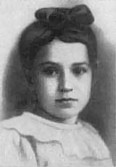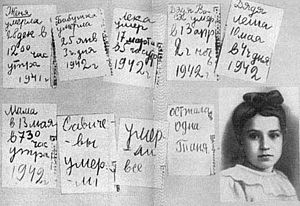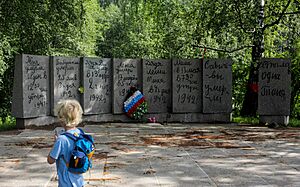Tanya Savicheva facts for kids
Quick facts for kids
Tanya Savicheva
|
|
|---|---|

Six-year-old Tanya Savicheva, 1936
|
|
| Born |
Tatyana Nikolayevna Savicheva
23 January 1930 Dvorishche, Gdovsky District, Leningrad Oblast, Russian SFSR, Soviet Union
|
| Died | 1 July 1944 (aged 14) Shatki, Gorky Oblast, Russian SFSR, Soviet Union
|
| Cause of death | Intestinal tuberculosis |
| Resting place | Krasny Born cemetery, Shatki, Nizhny Novgorod, Russia |
| Nationality | Russian |
Tanya Savicheva (born Tatyana Nikolayevna Savicheva on January 23, 1930 – died July 1, 1944) was a young Russian girl who kept a diary during World War II. Her diary tells the sad story of her family during the terrible siege of Leningrad in 1942.
During this siege, Tanya wrote down when each of her family members died. Her last entry showed she believed she was the only one left alive. Tanya was later rescued and taken to a hospital, but she passed away in July 1944 at age 14 from a serious illness called tuberculosis.
Tanya's image and the pages from her diary became a powerful symbol of how much people suffered during the siege of Leningrad. Today, there is a special memorial in St. Petersburg to remember her. Her diary was even used as proof of the terrible things that happened during the war at the Nuremberg Trials.
Contents
Tanya's Early Life
Tanya Savicheva was born on January 23, 1930. She was the youngest of five children. Her father was a baker, and her mother was a seamstress. Tanya's father died when she was six years old. This left her mother to care for Tanya and her four older siblings: Zhenya, Nina, Mikhail, and Leka.
Before the war started, Mikhail had already left Leningrad. He later joined a group of fighters called partisans in German-controlled areas. The rest of the family didn't know what happened to Mikhail and thought he had died.
In the summer of 1941, the family planned to go to the countryside. But then, on June 22, the Axis powers invaded the Soviet Union. This event, called Operation Barbarossa, changed everything. Everyone except Mikhail decided to stay in Leningrad.
During the war, each family member helped the country. Tanya's mother sewed uniforms, and Leka worked with airplanes. Zhenya and Nina worked in a factory making ammunition. Their uncles, Vasya and Lesha, helped with anti-aircraft defense. Even 11-year-old Tanya helped dig trenches and put out firebombs.
One day, Nina went to work and didn't come back. The family didn't know she had been secretly moved to Lake Ladoga and then evacuated. They thought she had died.
How the Diary Started
Tanya used to have a bigger diary where she wrote about her daily life. But early in the siege, her family had to burn it for fuel to heat their stove.
Later, Tanya was given a small notebook that belonged to her sister, Nina. This notebook became her famous diary. Nina had used it to write notes about equipment at her job, but there were still many empty pages.
Tanya wrote her first entry around December 28, 1941. This entry was about the death of her older sister, Zhenya. Zhenya likely died from severe malnutrition, made worse by her hard work at the factory. Zhenya walked long distances to work, sometimes for two shifts a day, making cases for mines. She also donated blood.
During the siege of Leningrad, food was very scarce. People were starving, and only small amounts of supplies came into the city across Lake Ladoga on the "Road of Life". It's thought that 100,000 people died each month from hunger. Zhenya's body was too weak to handle the blood donations, and she died in her apartment.
Family Deaths Recorded
Tanya began to record the deaths of her family members in Nina's notebook. She used a page for each person, marked with a Russian letter.
Her first entry was for her sister:
Женя умерла 28 дек в 12 00 час утра 1941 г (Zhenya died on December 28th at 12 noon, 1941)
After Zhenya, most of Tanya's family died quickly. Her grandmother, Yevdokiya Grigorievna, died a month later, just after Tanya's twelfth birthday. She died of heart failure and had lost a lot of weight. Tanya wrote:
Бабушка умерла 25 янв 3 ч. дня 1942 г (Grandmother died on the 25th of January at 3 o'clock, 1942)
Tanya later said that her grandmother had asked them to keep her ration card until the end of the month. So, her official death date was recorded as February 1, 1942. Her grandmother was buried in a mass grave at the Piskaryovskoye Memorial Cemetery.
On February 28, Nina disappeared. The family thought she had died because Leningrad was under heavy attack that day. But Nina had actually been evacuated across Lake Ladoga on the dangerous "Road of Life" ice route. She couldn't send a message to her family. Nina was ill for several months and didn't return to Leningrad until 1945. She was the one who later found Tanya's diary.
Tanya's brother Leka died in March 1942. He had tried to join the military but couldn't because of his nearsightedness. Leka was a talented engineer and musician. He worked long hours at the Admiralty Shipyard. Tanya quickly wrote in her diary:
Лека умер 17 марта в 5 часутр 1942 г. (Leka died March 17th at 5 o'clock in the morning, 1942)
On April 13, Uncle Vasya, one of her father's brothers, died at age 56. He had served in First World War but was too old for this war. Uncle Vasya and Tanya were very close. Tanya wrote about his death:
Дядя Вася умер в 13 апр 2 ч ночь 1942 г (Uncle Vasya died on April 13th at 2 o'clock in the morning, 1942)
Her oldest uncle, Lesha, died in May at age 71 from malnutrition. He also tried to join the military but was too old. Tanya recorded his death:
Дядя Леша 10 мая в 3 ч дня 1942 (Uncle Lesha May 10th, at 4 o'clock in the afternoon, 1942)
Finally, her mother died on the morning of May 13, 1942. Mariya Ignatievna Savicheva was born in 1889 and worked as a seamstress, sewing uniforms for soldiers during the war. Tanya wrote about her mother's death:
Мама в 13 мая в 7 30 час утра 1942 г (Mom on May 13 at 7:30 in the morning, 1942)
After her mother died, Tanya seemed to lose hope. She filled three more pages with these words:
« Савичевы умерли »
« Умерли все »
« Осталась одна Таня »
"The Savichevs are dead." "Everyone is dead." "Only Tanya is left."
After Her Rescue
After her mother's death, Tanya stayed with a neighbor. Then, even though she was very weak, she took her family's belongings to her aunt Evdokiya's house. Her aunt then sent Tanya to an orphanage, hoping she would get urgent medical care.
In August 1942, Tanya was one of 140 children rescued from Leningrad. They were taken to the village of Krasny Bor. A teacher there wrote to Tanya's brother Mikhail, who was outside Leningrad: "Tanya is now alive, but she doesn't look healthy. A doctor says she is very ill. She needs rest, special care, good food, a better climate, and most of all, tender motherly care." In May 1944, Tanya was sent to a hospital in Shatki, where she died a month later, on July 1, from intestinal tuberculosis.
Nina Savicheva and Mikhail Savichev returned to Leningrad after World War II. Mikhail had been fighting until 1944 and was injured. Tanya's original diary is now shown at the Museum of Leningrad History. A copy is also on display at the Piskaryovskoye Memorial Cemetery.
Tanya's small notebook was one of the documents shown by the Allied lawyers during the Nuremberg Trials.
What the Diary Says
Here are the exact words Tanya wrote in her diary:
Женя умерла 28 дек в 12 00 час утра 1941 г (Zhenya died on December 28th at 12 noon, 1941)
Бабушка умерла 25 янв 3 ч. дня 1942 г (Grandmother died on the 25th of January at 3 o'clock, 1942)
Лека умер 17 марта в 5 часутр 1942 г. (Leka died March 17th at 5 o'clock in the morning, 1942)
Дядя Вася умер в 13 апр 2 ч ночь 1942 г (Uncle Vasya died on April 13th at 2 o'clock in the morning, 1942)
Дядя Леша 10 мая в 3 ч дня 1942 (Uncle Lesha May 10th, at 4 o'clock in the afternoon, 1942)
Мама в 13 мая в 7 30 час утра 1942 г (Mom on May 13 at 7:30 in the morning, 1942)
Савичевы умерли (The Savichevs are dead)
Умерли все (Everyone is dead)
Осталась одна Таня (Only Tanya is left)
Tanya's Legacy
Tanya and her diary have become a powerful symbol of the children and people who suffered during the siege of Leningrad.
In 1968, a memorial was built to honor her. This memorial, called "The Flower of Life," has a large stone flower and eight stone tablets. These tablets look like pages from her diary, showing the names of her family members who died. It is located near St. Petersburg and is dedicated to all the children who lived through the siege.
At Krasny Bor cemetery, where Tanya is buried, there is a red marble tomb with a gray marble gravestone showing her image. Nearby, a tall stone wall shows carved pages from her diary.
A Serbian poet named Mika Antić wrote a poem about Tanya Savicheva. Also, a minor planet discovered in 1971 was named 2127 Tanya in her honor.
There is a mountain pass named after her in the Dzungarian Alatau mountains between Kazakhstan and China.
You can also find memorial plaques on the wall and in the courtyard of her home in St. Petersburg. There is also a museum in the school she attended.
Copies of Tanya's diary have been shown in exhibitions around the world. The original diary is kept at The State Museum of the History of St. Petersburg in the Peter and Paul Fortress.
Images for kids
See also
 In Spanish: Tatiana Sávicheva para niños
In Spanish: Tatiana Sávicheva para niños
- Mary Berg
- Anne Frank
- Věra Kohnová
- Yoko Moriwaki
- Rutka Laskier
- Lena Mukhina
- Sadako Sasaki
- List of posthumous publications of Holocaust victims







